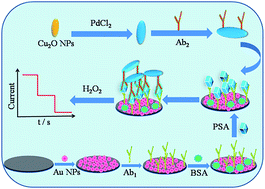Sandwich-type electrochemical immunosensor for ultrasensitive detection of prostate-specific antigen using palladium-doped cuprous oxide nanoparticles
Abstract
A new and facile sandwich-type electrochemical immunosensor is proposed for the ultrasensitive detection of prostate-specific antigen (PSA) based on Au nanoparticles (Au NPs) and palladium-doped cuprous oxide nanoparticles (Pd@Cu2O NPs). In this study, Au NPs were used as a substrate material to immobilize primary antibodies (Ab1) and to accelerate electron transfer. The Pd@Cu2O NPs were obtained through the prepared cuprous oxide nanoparticles (Cu2O NPs) by the in situ reduction of palladium chloride (PdCl2). The immunosensor was employed as a label for secondary antibodies (Ab2), presenting efficient electrocatalytic activity toward the reduction of hydrogen peroxide (H2O2). Under optimal conditions, the proposed immunosensor exhibited a wide linear response range from 10−5 to 100 ng mL−1 with a low detection limit of 2 fg mL−1. We thus established and demonstrated a simple, fast, and sensitive strategy for the ultrasensitive detection of PSA, which could find promising application in clinical diagnoses and other fields.


 Please wait while we load your content...
Please wait while we load your content...